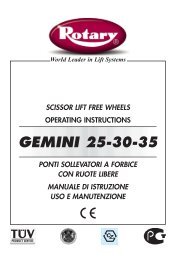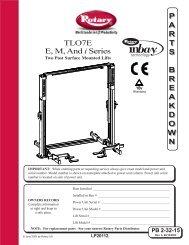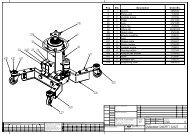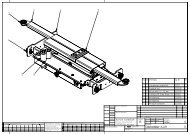Untitled - Trade Garage Equipment
Untitled - Trade Garage Equipment
Untitled - Trade Garage Equipment
- No tags were found...
You also want an ePaper? Increase the reach of your titles
YUMPU automatically turns print PDFs into web optimized ePapers that Google loves.
SINTOMO 33) The lowering button is pressed but the lift does notlower.POSSIBLE CAUSE 3:3A) Make sure there are no obstacles blocking thelowering phase.REMEDY - Remove the obstacle and carefully checkthe area before operating the lift.3B) Make sure the main switch is on and power supply isnot interrupted.REMEDY - Check and supply power to the car lift.3C) Blown fuse on the 24V power supply.REMEDY - Check and replace the fuse after eliminatingthe cause of the short-circuit.3D) Faulty transformer.REMEDY - Check the input and output voltage of thetransformer: in. 380 V, out. 24 V.3E) Valve coils are faulty or not supplied.REMEDY - Check whether valves are activated with24V directed to the coils.3F) Damaged or faulty valves.REMEDY - Unscrew the valves on the hydraulic blockone by one and make sure they move freely whensupplied with 24 volt solenoids.3G) Faulty lowering block proximetry, broken cable orimproperly connected to the cardREMEDY - Check the proximetry and replace it ifnecessary.SYMPTOM 44) The lift is closed but one of the two platforms is higher.POSSIBLE CAUSE 4:4A) Make sure there are no obstacles blocking the closingphase.REMEDY - Remove the obstacle and carefully checkthe area before operating the lift.4B) Platforms are not levelled.REMEDY - Should this problem occur, check the car liftfirst, and check for oil leaks from cylinders or pipes.To level the platforms, perform the following (ref. pict.15) :• Loosen the screws (A2-B2) 1/2 turn.• Press the “Lowering ” button and wait until platformsare levelled.• If the car lift does not move, loosen the screws (A1-B1).• Tighten the screws (A2-B2) and (A1-B1) in case theywere used.SYMPTOM 55) The lift does not stop at 250 mm from the ground butkeeps lowering, producing a warning signal during thelowering phasePOSSIBLE CAUSE 5:5A) Faulty or improperly installed proximetry.REMEDY - Check the proximetry and replace it ifnecessary.2I) Cilindri bloccati .RIMEDIO - Contattare l’assistenza tecnica.SINTOMO 33) Pulsante di discesa premuto ed il ponte non scende.PROBABILE CAUSA 3:3A) Controllare che non vi siano ostacoli cheimpediscono la discesa.RIMEDIO - Rimuovere l’ostacolo prestare comunquemassima attenzione prima di eseguire manovre con ilponte.3B) Controllare che l’interruttore generale sia attivato eche l’alimentazione non sia interrotta.RIMEDIO - Controllare ed eventualmente inserirecorrente al ponte.3C) Fusibile saltato sull’alimentazione 24 volt.RIMEDIO - Controllare ed eventualmente sostituire ilfusibile dopo aver eliminato la causa del corto.3D) Trasformatore guasto.RIMEDIO - Controllare la tensione d’ingresso e di uscitadel trasformatore in. 380 V, usc. 24 V.3E) Le bobine sulle valvole difettose o non alimentate.RIMEDIO - Controllare se con 24 volt diretti sullebobine, le valvole vengano attivate.3F) Valvole guaste o difettose.RIMEDIO - Svitare una valvola alla volta dal bloccoidraulico e controllare dce siano libere di muoversiquando vengono alimentate tramite i solenoidi con 24volt.3G) Proximetri di stop discesa guasto o cavo tagliato onon perfettamente connesso alla scheda.RIMEDIO - Controllare ed eventualmente sostituire ilproximetri.SINTOMO 44) Il ponte è chiuso è una delle due pedane rimane piùalta.PROBABILE CAUSA 4:4A) Controllare che non vi siano impedimenti o ostacoliche blocchino la chiusura.RIMEDIO - Rimuovere l’ostacolo e prestare comunquemassima attenzione prima di eseguire manovre con ilponte.4B) Dislivello delle pedane.RIMEDIO - Se dovesse comparire questo problema,per prima cosa controllare e verificare il sollevatore,controllare che non vi siano perdite d’olio dai cilindri odai tubi.Per rilivellare le pedane operare come segue (rif. fig.15) :• Allentare le viti (A2-B2) di 1/2 giro.• Premere il tasto “Discesa” e aspettare che le pedanesi rilivellano.• Se il ponte Rimane fermo allentare le viti (A1-B1).• Serrare le viti (A2-B2) e le viti (A1-B1) qualora siastato necessario il loro utilizzo.___________________________________________________________________________23
















